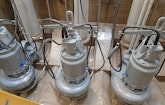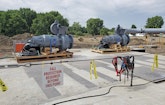
The city of Lima, Ohio, agreed to construct a 13 million-gallon CSO storage tank as part of a 2014 consent decree with the EPA. The project, which cost nearly $40 million, was part of $147 million in overall improvements required by the consent decree. (Images Courtesy of Xylem, Inc.)
Interested in Stormwater?
Get Stormwater articles, news and videos right in your inbox! Sign up now.
Stormwater + Get AlertsThe city of Lima, Ohio, struggled with combined sewer overflow issues for decades. Something had to change.
Of the city’s 251 miles of sewer lines, roughly 130 miles are combined storm and sanitary sewers. Lima’s 90-year-old wastewater treatment plant serves more than 40,000 people within city limits and surrounding communities, and treated wastewater is released into the Ottawa River. But during heavy rain events, the collection system also allows untreated overflows to discharge into the river.
Over the years, the city sought various solutions to the ongoing challenges with CSOs. In the mid-1970s, Lima made its first serious attempt at solving the CSO problem by installing a large sewer interceptor pipeline and five CSO control structures along the Ottawa River. The combined storm and sewer flow in the interceptor and the five CSO control structures are controlled by a sophisticated real-time flow control system.
Then, in 2002, the city installed raked bar screens on the five CSO control structures along the Ottawa River. Raked bar screens are designed to keep stormwater debris in the wastewater channel where it continues on to the treatment plant for removal and disposal. This created more capacity in control structures and helped prevent accidental discharge into the river.
Despite these improvements, the city continued to experience overflows. During heavy rain events, wastewater and stormwater flowed untreated into the Ottawa River. The CSOs threatened public health and caused damage to the aquatic environment.
Overcoming obstacles
As a result, in 2014, the City of Lima and the U.S. Environmental Protection Agency finalized negotiations for a consent decree to implement the improvements recommended under the city’s integrated plan to control CSOs and sanitary sewer overflows.
The consent decree required the city to more than double wastewater treatment capacity — from 30 million gallons per day to 70 mgd. The EPA also mandated the city to get down to no more than five overflows in a typical year of rainfall. The city has between 25 and 45 rains heavy enough to trigger overflows in a typical year.
Consequently, the city agreed to construct a 13-million-gallon CSO storage tank, separate sanitary sewer overflow abatement improvements and upgrades to the wastewater treatment plant. The CSO project, which cost nearly $40 million, was part of $147 million in overall improvements required by the consent decree — the largest in the utility department’s history.
Integrated planning
Following the consent decree, Lima used integrated planning to determine a comprehensive approach to reduce the number of CSOs. They used this holistic approach to look at the entire collections system and the wastewater treatment plant, determining what capital improvements could be implemented to achieve the EPA’s established goals. Integrated planning also allowed Lima to consider financial feasibility to complete the upgrades and stretched the mandated projects out through 2038.
The city engaged engineering consulting firm Stantec to design the solution for its CSO reduction goals. Peterson Construction served as the general contractor on the project, and Woolace Electric installed all of the electrical components.
By having a large basin to collect excess overflow, discharges in the river can be prevented, with collected overflow pumped to the wastewater treatment plant for treatment prior to release into the river. The tank, located more than 45 feet underground, required digging through 17 feet of rock to reach the proper depth.
The CSO tank stores flow from the collections system for treatment following wet weather events. Situated near an existing CSO outfall, the offline storage tank accepts flow by gravity.
Once water levels have reduced and capacity has returned within the collections system, the tank is dewatered via submersible pumps at a rate of up to 30 mgd. Flow is then pumped to the sewer system for treatment at the city’s wastewater treatment center. The tank is constructed of 3- to 4-foot-thick concrete walls and includes a flushing gate and odor control system. The project also called for a diversion structure, utility pipe bridge crossing and underground gate structure improvements for improved flow management and control of CSOs.
Built adjacent to Simmons Field, where the collegiate summer league Lima Locos play, the massive 13-million-gallon tank measures 200 feet wide by 400 feet long and 45 feet deep. More than 75,000 cubic yards of rock was excavated and hauled off site, according to Utilities Director Michael Caprella. More than 35,000 cubic yards of concrete was poured to construct the holding tank.
Flygt distributor Buckeye Pumps equipped the pump station with three Flygt NP3531 20-inch units, each with 130 hp closed-loop cooled motors. A connecting pipe that runs over the Ottawa River on a utility pipe bridge helps transfer water into the 54-inch sewer line that feeds into the WWTP when crews dewater the underground CSO basin.
Installed at a depth of 55 feet, the pumps provide several value-added features aside from the 30 mgd pumping capacity. Those include sustained efficiency, self-cleaning hydraulics and durability with the high chrome impellers. The Flygt deep lift mechanism does not require a permanently attached lifting chain or cable to the pump. This added feature helps simplify installation and maintenance when needed, eliminating any need for personnel to enter the wet well.
CSOs today
Completed in the fall of 2020, the project was nine months ahead of schedule and under budget. Upon completion of the overflow tank, the site reverted to a green space, which will be used for recreational purposes.
Since going online, the new pump station and CSO tank have helped protect the community and environment by significantly reducing combined sewer overflows to the Ottawa River.
Lima expects to see the number of CSOs continue to drop as engineers continue to optimize the set points for the CSO storage tank, along with the plant upgrades. The next step in moving forward with the consent decree requirements will be eliminating sanitary sewer overflows during heavy rain events at seven different locations, all at pump stations.
The city is currently evaluating methods to reduce flows to these pump stations to reduce the scale of the pumping, and flow equalization improvements.








